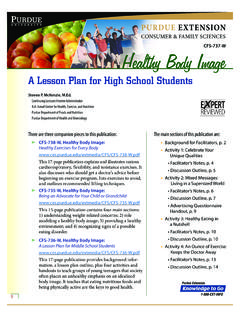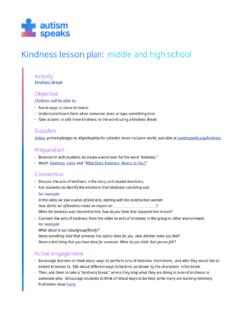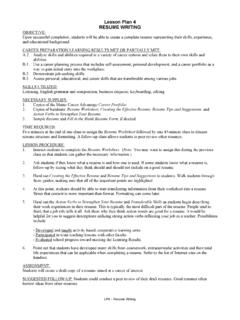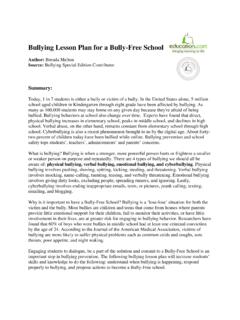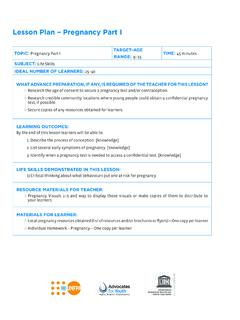Transcription of Emotion a unit lesson plan for high school psychology teachers
1 DDeveloped and produced by the teachers of psychology in Secondary Schools (TOPSS) of the American Psychological Association, May 2010 Emotiona unit lesson plan for high school psychology teachersRevised by Shirley Collins, Mary Jarvis, Don Kober, Brian LeCloux, Trudy Loop, Robert Peterson, Wanda Wilson, Ronald Wood, and Amy FineburgNancy Dess, PhDFaculty Consultant, Occidental College Emotiona unit lesson plan for high school psychology teachersRevised by Shirley Collins, Mary Jarvis, Don Kober, Brian LeCloux, Trudy Loop, Robert Peterson, Wanda Wilson, Ronald Wood, and Amy FineburgNancy Dess, PhDFaculty Consultant, Occidental Collegeii Emotiona unit lesson plan for high school psychology teachersThis unit was based on the original TOPSS Unit lesson plan on Motivation and Emotion developed by Fred Cunnington, Carol L. Farber, Jim Hoppe, Cheryl Jordan, Lisa G.
2 Kopacz, Paul Mueller, Marti C. Mueting, and Chuck Schira (Craig W. Gruber, Editor; James E. Freeman, PhD, University of Virginia, Faculty Consultant). We thank Heather Adams, PhD, of Ball State University, and James Kalat, PhD, of North Carolina State University, for their reviews of this document. Copyright 2010 by the American Psychological Association. All rights reserved. No part of this publication may be reproduced or distributed in any form without prior written permission of the publisher. iii contents 1 Procedural Timeline 3 Content Outline 13 Activities 45 References 47 Resources1 lesson 1: Introduction to EmotionActivity : Human Emotions (with Handout ) lesson 2: The Neuroscience of EmotionActivity : The Autonomic Nervous SystemLesson 3: Types of EmotionActivity : Differentiating Between Jealousy and Envy (with Handout ) lesson 4: Emotional ExperienceActivity : Facial Feedback Hypothesis (with Handout ) Transparency Master : Theories of EmotionActivity : What Do You Fear?
3 (with Handout )Activity : The PANAS (Positive and Negative Affect Schedule) (with Handout ) lesson 5: Emotional Communication Activity : Flashing Faces (with Handout )Activity : Perspective Takingprocedural timelineprocedural outline3 lesson 1: Introduction to EmotionI. Defining Emotion A. No well-accepted definition of Emotion exists. Difficulty in defining Emotion hampered research on it for a long Activity : Human Emotions (with Handout ) B. A useful definition is a relatively brief episode of synchronized evaluative physiological, behavioral, and subjective responses. C. The term Emotion usually is distinguished from feelings, mood, and affect. 1. Feeling: the subjective experience associated with an Emotion . 2. Mood: an emotional state that is general and extended in time. 3. Affect: encompasses feelings and mood and categories of Emotion ( , positive or negative affect).
4 D. Emotion functions to: 1. Increase, decrease, or regulate arousal 2. Direct perception and attention 3. Influence learning and memory 4. Organize and motivate behavior 5. Communicate with otherscontent outlinecontent outline4 lesson 2: The Neuroscience of EmotionI. Brain mechanisms of emotional recognition and experience A. Brain systems important in Emotion 1. Many interrelated brain structures are involved in the recognition and experience of various emotions, often loosely defined as the limbic system (Calder, Burton, Miller, Young, & Akamatsu, 2001). 2. Several subcortical structures are important in Emotion . a. Damage to the amygdala impairs recognition and expression of fear, anger, and happiness. b. Damage to the basal ganglia impairs recognition and expression of disgust. 3. Several areas of the cortex also are important in Emotion , including the prefrontal cortex, posterior cortex, and insula.
5 B. Lateralized function of cerebral hemispheres 1. Right hemisphere a. high activity is associated with depression and flexion (avoidant) motions. b. More active than left hemisphere during displays of many emotions. c. Damage often leaves individuals emotionally indifferent and unable to read many emotions. 2. Left hemisphere a. More active than right during smiling, positive emotions, and extension (approach) motions. b. Relatively low activity in the left frontal lobe is associated with depression. 3. Two theories a. Right-hemisphere theory: Right hemisphere dominant in all emotional processing. b. Valence theory: Right hemisphere dominant for negative emotions; left dominant for positive emotions. c. Evidence for both exists. Current theorizing focuses on interhemispheric integration to reconcile findings (Achuff, 2001; Killgore & Yurgelun-Todd, 2007).
6 II. Neuroendocrine arousal mechanisms A. The hypothalamic-pituitary-adrenal system controls stress hormones that facilitate short-term coping with emotional events. 1. Hypothalamus: Brain region that regulates hormonal functions via the pituitary gland. 2. Pituitary gland: Master gland that receives messages from hypothalamus and relays signals to endocrine glands to regulate hormones. 3. Adrenal glands: Located atop the kidneys; top part (adrenal cortex) responds to signals from pituitary by releasing stress hormones such as cortisol into the outline5 B. The autonomic nervous system controls responses to cognitive and environmental stimuli that give rise to emotional responses. See Activity : The Autonomic Nervous System 1. The sympathetic nervous system releases norepinephrine onto peripheral targets ( , organs, glands, or muscles) to prepare the body for vigorous activity ( , increased respiration, sweating, and heartbeat).
7 A. Stimulation of the adrenal medulla causes release of epinephrine and norepinephrine into the blood. 2. The parasympathetic nervous system releases acetylcholine onto peripheral targets ( , organs, glands, or muscles) to relax the body after the activity is over ( , slows heartbeat).III. Application: Lie detection A. People have tried to develop a reliable way to detect deception for hundreds of years. B. During the 20th century, devices sensitive to sympathetic nervous system (SNS) activity were developed as lie detectors. 1. The logic is that lying makes people nervous, which is reflected in increased SNS activity ( , racing heart, sweaty hands). 2. SNS responses to key questions ( Did you rob the bank? Do you cheat on your taxes? ) are compared to control questions ( Is today Tuesday? ). Larger responses on key questions are supposed to indicate lying.
8 3. Polygraph results are only rarely admissible in court. In 1988, a law made it illegal for employers to ask employees to take a polygraph test except under limited circumstances. C. Critique: Lie detector machines are unreliable. Good liars may be judged truthful, and honest people may be judged to be lying (National Research Council, 2003). D. Alternative approaches 1. Guilty knowledge test: Measures reactions to information that only a guilty person would know. Intent to lie or tell the truth is irrelevant. 2. Identification of and training to detect reliable facial and behavioral cues to deception (Ekman, 2002). lesson 3: Types of EmotionI. Basic emotions A. According to one view, people have a few basic emotions, analogous to the elements of chemistry. According to a competing view, emotional feelings occur along two or more continuous dimensions, such as pleasure vs.
9 Displeasure and activity vs. outline6 B. Among those who accept the idea of basic emotions, this list of such emotions is widely agreed to include anger, disgust, fear, happiness, sadness, and interest. Other candidates for the status of basic Emotion include contempt and amusement. C. Expression and recognition emerge early in life but continue to develop through adolescence (Herba, Landau, Russell, Ecker, & Philllips, 2006). 1. Emotions expressed at birth are just global arousal states; infants show little anger until 6 8 months, when they also start to show fear (especially stranger anxiety). D. Facial expressions associated with basic emotions show high cross-cultural recognition (Ekman, Sorenson, & Friesen, 1969). 1. However, cultural differences exist between individualistic ( , ) and collectivist ( , China) cultures. For example, Chinese adults discourage expression of strong emotions, and Chinese children cry and smile less at one year of age compared with Self-conscious and social emotions A.
10 Includes emotions such as shame, guilt, contempt, pride, envy, and empathy. B. These emotions fully develop later than basic emotions because they depend on landmarks in cognitive development, such as a sense of self and theory of mind. C. Recognition of social emotions appears to depend even more than basic emotions on the amygdala (Adolphs, Baron-Cohen, & Tranel, 2002).See Activity : Differentiating Between Jealousy and Envy (with Handout )III. Refined emotions A. Definition: A new concept for aspects of emotional experience that require higher mental processes, such as higher order awareness (Frijda & Sundararajan, 2007). B. Basic and self-conscious emotions are refined through an abstract, overall sense of things (harmony) or the active search for harmony and heightened emotional experience (savoring). C. Refined emotions have minimal outward 4: Emotional ExperienceI.










